KTM 640LC4 User Manual
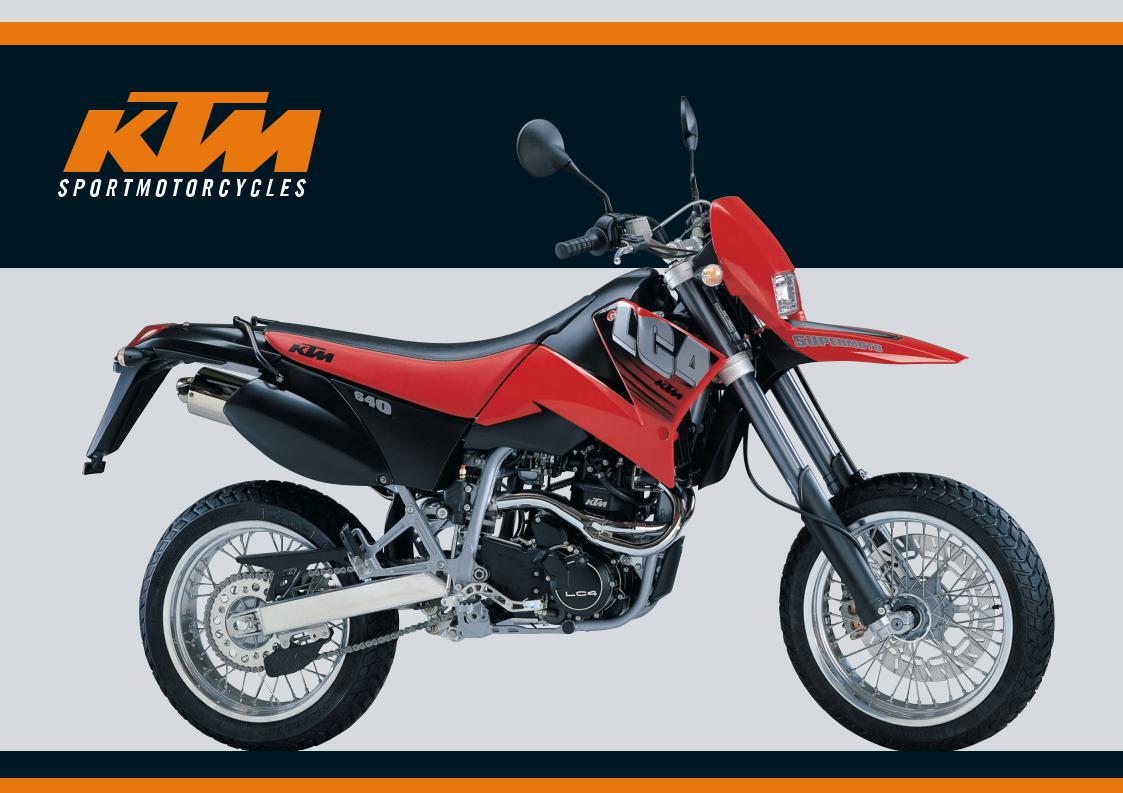
640 LC4 640 LC4 SUPERMOTO
BEDIENUNGSANLEITUNG
OWNERS HANDBOOK MANUALE D’USO MANUEL D’UTILISATION
MANUAL DE INSTRUCCIONES
2002
Art.Nr. 3.210.21 9/2001

IMPORTANT
WE STRONGLY SUGGEST THAT YOU READ THIS MANUAL CAREFULLY AND COMPLETELY BEFORE GOING ON YOUR FIRST RIDE. IT CONTAINS A GREAT DEAL OF INFORMATION AND ADVICE WHICH WILL HELP YOU USE AND HANDLE YOUR BIKE PROPERLY. IN YOUR OWN INTEREST, PLEASE PAY PARTICULAR ATTENTION TO NOTICES THAT ARE MARKED AS FOLLOWS:
WARNING
IGNORING THESE INSTRUCTIONS, CAN ENDANGER YOUR BODY AND YOUR LIFE.
! |
CAUTION |
! |
IGNORING THESE INSTRUCTIONS COULD CAUSE DAMAGE TO PARTS OF YOUR MOTORCYCLE OR THAT THE MOTOR-CYCLE IS NOT ROAD-SAFE ANYMORE.
Please insert the series numbers of your motorcycle in the boxes below
Chassis number
Engine number
Stamp of dealer
CONSUMER INFORMATION FOR AUSTRALIA ONLY
TAMPERING WITH NOISE CONTROL SYSTEM PROHIBITED
Owners are warned that the law may prohibit:
(a)The removal or rendering inoperative by any person other than for purposes of maintenance, repair or replacement, of any device or element of design incorporated into any new vehicle for the purpose of noise control prior to its sale or delivery to the ultimate purchaser or while it is in use; and
(b)the use of the vehicle after such device or element of design has been removed or rendered inoperative by any person.
KTM SPORTMOTORCYCLE AG RESERVES THE RIGHT TO MODIFY ANY EQUIPMENT, TECHNICAL SPECIFICATIONS, COLORS,
MATERIALS, SERVICES OFFERED AND RENDERED, AND THE LIKE SO AS TO ADAPT THEM TO LOCAL CONDITIONS WITHOUT PREVIOUS ANNOUNCEMENT AND WITHOUT GIVING REASONS, OR TO CANCEL ANY OF THE ABOVE ITEMS WITHOUT SUBSTI-
TUTING THEM WITH OTHERS. IT SHALL BE ACCEPTABLE TO STOP MANUFACTURING A CERTAIN MODEL WITHOUT PREVIOUS ANNOUNCEMENT. IN THE EVENT OF SUCH MODIFICATIONS, PLEASE ASK YOUR LOCAL KTM DEALER FOR INFORMATION. WE SHALL NOT BE HELD LIABLE FOR ANY PRINTING ERRORS.
ENGLISH 1

|
Introduction |
|
|
We would like to congratulate you on your purchase of a KTM motorcycle. |
|
|
You are now the owner of a state-of-the-art sports motorcycle that guarantees to |
|
|
bring you lots of fun and enjoyment, provided that you clean and maintain it |
|
|
appropriately. Before you go for your first ride, be sure to read this manual |
|
|
carefully and thoroughly in order to familiarize yourself with how to operate |
|
|
your new motorcycle and with its characteristics, even if this means that you |
|
|
have to dedicate some of your valuable time to this task. Only by doing so will |
|
ENGLISH |
you learn how to tune your motorbike to your specific needs and how to protect |
|
yourself against injury. Besides, this manual contains important information on |
||
|
||
|
motorcycle maintenance. At the time this manual was typeset, it was up-to-date |
|
|
with the latest state of this production series. It cannot be completely ruled out, |
|
|
however, that there may exist minor discrepancies resulting from further design |
|
|
upgrades of these motorcycles. |
|
|
This manual is an important part of your motorbike and should be passed on to |
|
|
any subsequent owner in case you decide to sell it. |
2Many motorcyclists have a good working knowledge of motorcycle mechanics; if this is true in your case, you will be able to use this manual to carry out most of the maintenance steps yourself. If, on the other hand, you are not very familiar with motorcycles, it might be better to have a professional KTM dealer perform
those steps marked * described in the chapter entitled “Maintenance Work on Chassis and Engine” of this manual.
For your own safety use only KTM-approved parts and accessories. KTM is not liable for damage that arises in connection with the use of other products.
Take special care to follow the recommended run in, inspection, and maintenance intervals. Heeding these guidelines will significantly increase the life of your motorcycle. Have services carried out by a KTM dealer so that your warranty claim remains intact.
Contact a specialized KTM workshop supported by the KTM importer if you have any special wishes. Please remember to wear a helmet, protective glasses and protective clothing while driving. KTM drivers are considerate drivers.
We wish you a lot of fun when driving !
KTM Austria’s certificate of achievement for its Quality System ISO 9001 is the beginning of an on-going total re-engineering quality plan for a brighter tomorrow.
KTM SPORTMOTORCYCLE AG 5230 MATTIGHOFEN, AUSTRIA
ALL RIGHTS RESERVED TO MAKE ALTERATIONS TO DESIGN AND MODEL.
© by KTM SPORTMOTORCYCLE AG, AUSTRIA All rights reserved

INDEX
|
Page |
SERIAL NUMBER LOCATIONS ............................................. |
4 |
Chassis number ................................................................ |
4 |
Engine number, engine type............................................. |
4 |
OPERATION INSTRUMENTS ............................................... |
4 |
Clutch lever ...................................................................... |
4 |
Hand decompression lever................................................ |
4 |
Choke lever ...................................................................... |
5 |
Hand brake lever .............................................................. |
5 |
Speedometer, indicator lamps........................................... |
5 |
Ignition lock ..................................................................... |
5 |
Combination switch.......................................................... |
6 |
Starter tip switch, emergency OFF switch ......................... |
6 |
Filler cap........................................................................... |
6 |
Fuel .................................................................................. |
6 |
Fuel tap ............................................................................ |
7 |
Shift lever ......................................................................... |
7 |
Kickstarter ........................................................................ |
7 |
Foot brake pedal .............................................................. |
7 |
Compression damping of fork .......................................... |
8 |
Rebound damping of fork ................................................ |
8 |
Compression damping of shock absorber ......................... |
8 |
Rebound damping of shock absorber ............................... |
8 |
Holding bars..................................................................... |
8 |
DRIVING INSTRUCTIONS .................................................... |
9 |
PERIODIC MAINTENANCE-SCHEDULE .............................. |
14 |
MAINTENANCE WORK ON CHASSIS AND ENGINE .......... |
16 |
Tool set .......................................................................... |
16 |
Removing the seat.......................................................... |
16 |
Checking and adjusting steering head bearing................ |
17 |
Changing the spring preload of the shock absorber ........ |
17 |
Lubricate shock absorber linkage .................................... |
17 |
Checking rubber ring on the rear shock absorber............ |
18 |
Checking chain tension................................................... |
18 |
Correct chain tension...................................................... |
18 |
Chain maintenance......................................................... |
18 |
Chain wear..................................................................... |
19 |
General information on KTM disc brakes ........................ |
19 |
Adjisting of free travel at the hand brake lever ............... |
19 |
Checking of brake fluid level - front brake...................... |
20 |
Refilling the front brake fluid reservoir............................ |
20 |
Checking the front brake pads........................................ |
20 |
Changing the basic position of the foot brake pedal ....... |
20 |
|
|
Page |
Check the rear brake fluid level ...................................... |
|
21 |
Refilling the rear brake fluid reservoir ............................. |
|
21 |
Checking the rear brake pads ......................................... |
|
21 |
Dismounting and mounting the front wheel (LC4) ......... |
22 |
|
Dismounting and mounting the front wheel (LC4 Supermoto).22 |
||
Dismounting and mounting the rear wheel..................... |
|
23 |
Checking the shock absorbtion rubbers in the rear hub....... |
23 |
|
Tires, air pressure............................................................ |
|
24 |
Checking spoke tension.................................................. |
|
24 |
Battery ........................................................................... |
|
25 |
Charging the battery ...................................................... |
|
25 |
Main fuse ....................................................................... |
|
26 |
Fuses for individual power-consuming units ................... |
|
26 |
Exchanging the headlight lamp....................................... |
|
26 |
Replacing the parking light bulb ..................................... |
|
26 |
Exchanging the brake light and tail light bulb ................. |
|
27 |
Cooling system............................................................... |
|
27 |
Checking the cooling liquid level .................................... |
|
28 |
Cleaning the air filter ...................................................... |
|
28 |
Adjusting idling speed .................................................... |
|
28 |
Adjusting the throttle cable ............................................ |
|
29 |
Draining the carburetor float chamber............................ |
|
29 |
Adjusting the clutch cable............................................... |
|
29 |
Checking and adjusting the chocke cable play ................ |
|
30 |
Checking the adjustment of the hand decompression cable ..... |
30 |
|
Engine oil ....................................................................... |
|
30 |
Checking the engine oil level .......................................... |
|
30 |
Oil circuit........................................................................ |
|
31 |
Oil and fine screen filter change, bleeding of the oil system 31 |
||
Changing oil filter .......................................................... |
|
32 |
TROUBLE SHOOTING........................................................ |
|
33 |
CLEANING.......................................................................... |
|
36 |
CONSERVATION FOR WINTER OPERATION .................... |
|
36 |
STORAGE ........................................................................... |
|
36 |
Re-initation after time of storage.................................... |
|
36 |
TECHNICAL SPECIFICATIONS - CHASSIS........................... |
|
37 |
TECHNICAL SPECIFICATIONS - ENGINE .......................... |
|
38 |
CONSUMER INFORMATION FOR USA ONLY .................. |
|
40 |
HEAD WORD INDEX.......................................................... |
|
43 |
WIRING DIAGRAM................................................ |
APPENDIX |
|
ENGLISH 3
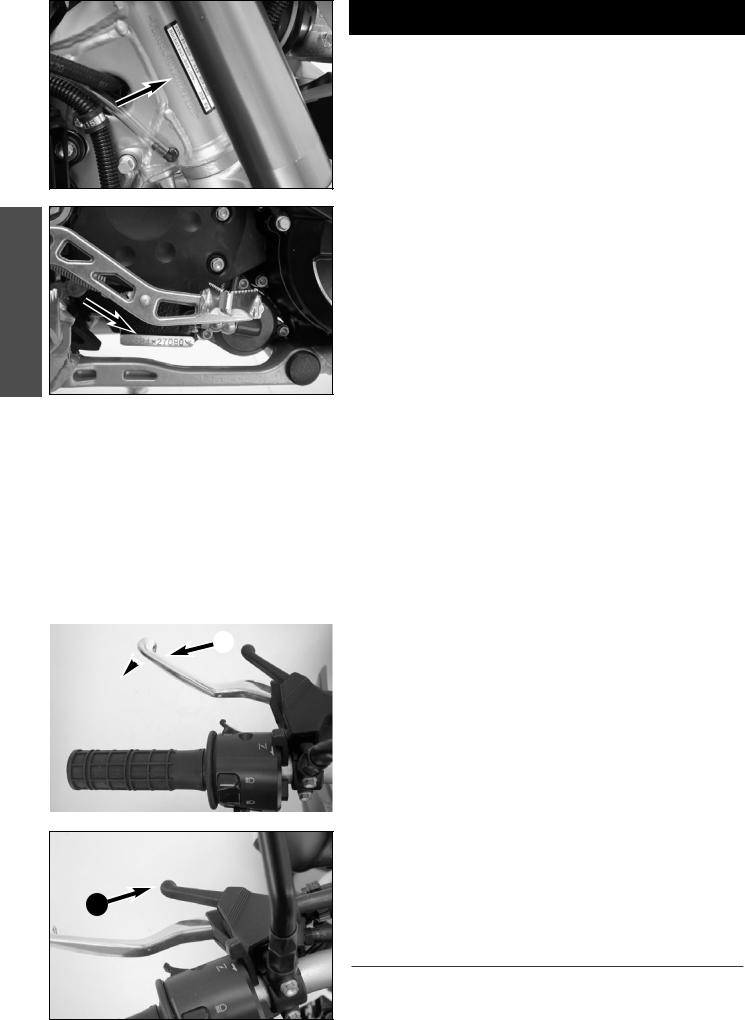
ENGLISH 4
SERIAL NUMBER LOCATIONS
Chassis number
The chassis number is stamped on the right side of the steering head tube.
Write this number into the relevant area on page 1.
Engine number, engine type
The engine number and engine type are stamped on the right hand side of the engine below the chain sprocket. Write this number into the relevant area on page 1.
|
|
|
|
|
|
OPERATION INSTRUMENTS |
|
||
|
1 |
|
|
|
|||||
|
|
|
|
|
|
Clutch lever |
|
|
|
|
1-3 mm |
|
|
|
|
The clutch lever 1 is fitted on the left hand side of the handle bar. When |
|
||
|
|
|
|
|
|
engine is cold, there should allways be a play of 1–3 mm (0,04–0,1 in) at |
|
||
|
|
|
|
|
|
|
|||
|
|
|
|
|
|
this lever (measured at outer edge). |
|
|
|
|
|
|
|
|
|
|
|
|
|
|
|
|
|
|
|
! |
CAUTION |
! |
|
|
|
|
|
|
|
IF THERE IS NO PLAY ON THE CLUTCH LEVER, THE CLUTCH WILL START TO SLIP. THE |
|
||
|
|
|
|
|
|
CLUTCH WILL THEN OVERHEAT, DESTROYING THE CLUTCH LININGS. |
|
|
|
|
|
|
|
|
|
|
|
|
|
|
Hand decompression lever |
|
The hand decompression lever 2 is only used in two special cases: |
|
a)When the engine stalled. |
|
It is possible that the starter motor is not able to crank the engine on the |
|
next attempt. This is due to the fact that the automatic decompressor |
2 |
doesn’t work properly. If this happens, pull the manual decompression |
|
lever and start again. Afterwards normal starting will be possible. |
|
b) When you want to push the motorcycle. |
|
While pushing, pull the hand decompression lever to make it easier to get |
|
the engine going. |
! |
CAUTION |
! |
THE SETTING OF THE HAND DECOMPRESSION CABLE SHOULD BE REGULARLY CHECKED (SEE MAINTENANCE WORK). A LACK OF PLAY IN THE HAND DECOMPRESSION LEVER CAN RESULT IN ENGINE DAMAGE.
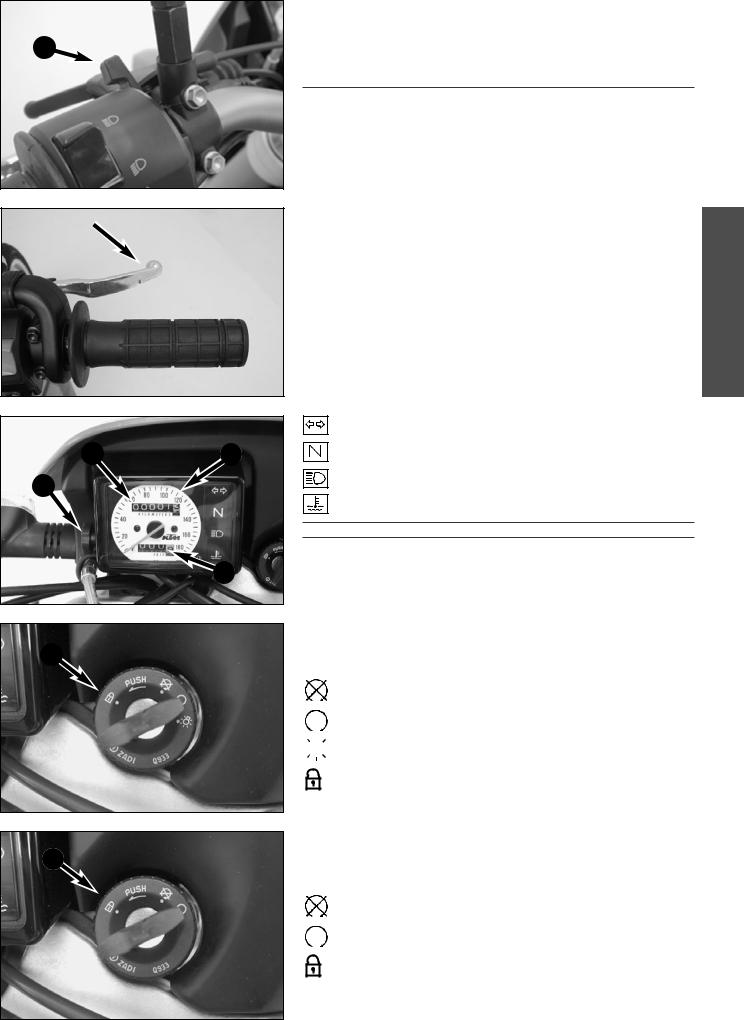
Choke lever
If the choke lever 1 is pulled backwards, a bore will be opened in the carburetor through which the engine may draw in additional fuel. This 1 produces a „rich“ fuel/air mixture necessary for cold start. If the choke lever is pushed forward up to the stop, the bore will be closed again. In this
position the choke cable must have a play of approx. 4 mm.
! |
CAUTION |
! |
IF THERE IS NO PLAY IN THE CHOKE CABLE, THE BORE OF THE COLD STARTER SYSTEM
CANNOT BE COMPLETELY CLOSED. THIS RESULTS IN HIGH FUEL CONSUMPTION, AN
UNEVEN RUNNING ENGINE, AND AN EXTREME WEAR OF PISTON AND CYLINDER.
A |
2 |
C
B
3
4
Hand brake lever
The hand brake lever is mounted on the handlebar on the right and actuates the front wheel brake.
|
WARNING |
|
IF THE RESISTANCE IN THE HAND BRAKE LEVER OR FOOT BRAKE PEDAL FEELS “SPONGY” (TOO MUCH GIVE), THIS IS AN INDICATION THAT SOMETHING IS WRONG WITH THE BRAKE SYSTEM. DON’T RIDE YOUR MOTORCYCLE ANYMORE WITHOUT FIRST HAVING THE BRAKE SYSTEM LOOKED OVER BY A KTM DEALER.
Speedometer, indicator lamps
The mileage indicator A in the speedometer 2 indicates overall mileage. The day mileage indicator B can be set to 0 by means of the setting wheel C. Turn the setting wheel forward until only zeros can be seen in the display.
The green indicator lamp flashes when the flasher light is working in the same rhythm as the flasher light.
The green indicator lamp lights up when the gear is switched to idle.
The blue indicator lamp lights up when the high beam is on.
The red cooling liquid temperature warning lamp lights up at a cooling liquid temperature of 105°C (223°F).
! CAUTION !
POSSIBLE CAUSES FOR THE RISE IN TEMPERATURE AND THE LIGHTING OF THE RED COOLING LIQUID TEMPEREATURE WARNING LIGHT:
–SLOW RIDING WITH LARGE LOADS AT A HIGHER AIR TEMPERATURE
–TOO LITTLE COOLING LIQUID IN THE SYSTEM
–THE COOLING FAN ON THE LEFT COOLER IS NOT WORKING
– EXCESSIVE USE OF THE CLUTCH AT SLOW SPEED |
(SEE PAGE 27 ) |
Ignition lock with 4 switch positions
Switch positions of ignition lock 3:
Ignition off, light off (engine can't be started)
Ignition on, light off (engine can be started)


 Ignition on, light on (engine can be started) Riding just with lights!
Ignition on, light on (engine can be started) Riding just with lights!
Ignition off, light off, handlebar blocked
To switch the ignition to position  turn the ignition key to position
turn the ignition key to position
 and firmly press it into the lock. Turn the handlebar all the way to the left, then turn the ignition key to the left.
and firmly press it into the lock. Turn the handlebar all the way to the left, then turn the ignition key to the left.
The ignition key can be withdrawn in position  and
and  .
.
Ignition lock with 3 switch positions
Switch positions of ignition lock 4:
Ignition off, light off (engine can't be started)
Ignition on, light on (engine can be started)
Ignition off, light off, handlebar blocked
To switch the ignition to position  turn the ignition key to position
turn the ignition key to position
 and firmly press it into the lock. Turn the handlebar all the way to the left, then turn the ignition key to the left.
and firmly press it into the lock. Turn the handlebar all the way to the left, then turn the ignition key to the left.
The ignition key can be withdrawn in position  and
and  .
.
ENGLISH 5
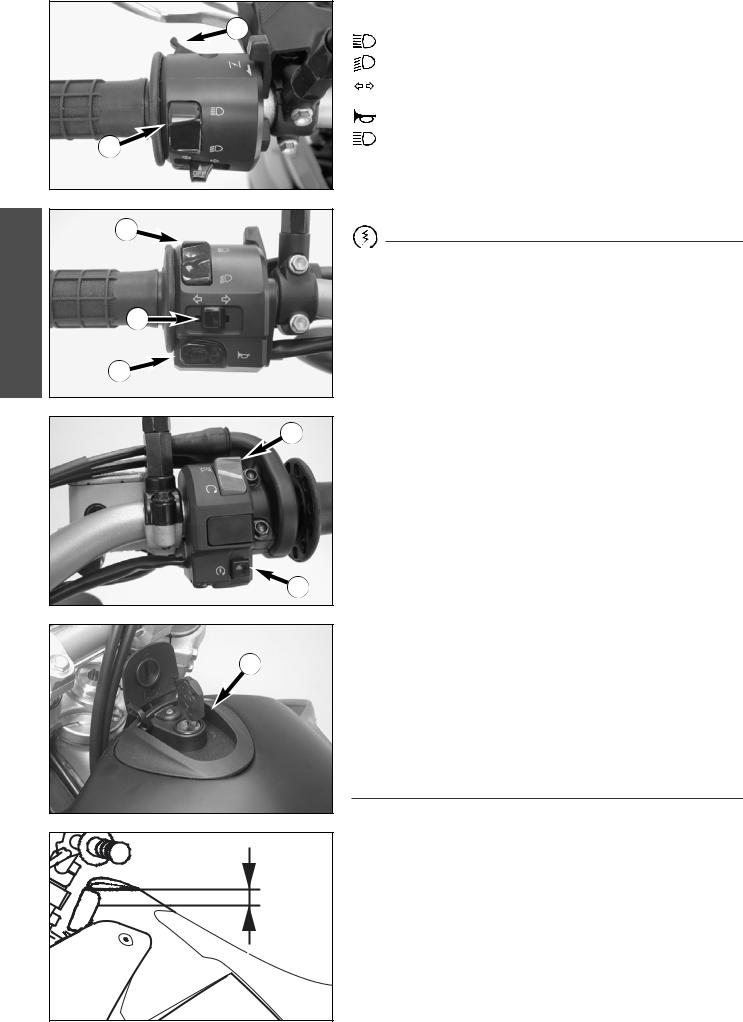
ENGLISH 6
4
1
1
2
3
6
7
35 mm
Combination switch
The rocker switch LIGHTS 1 actuates the high beam or low beam.
= High-beam light
= Low-beam light
The indicator switch 2 returns to central position after actuation. Press flasher switch towards switch housing to switch off the flasher.
The horn is sounded with button 3.
The light signal (high beam) is actuated with button 4.
Starter tip switch, emergency OFF tip switch
Use the starter tip switch 5 to operate the electric starter.
|
! |
CAUTION |
! |
MAXIMUM PERIOD |
FOR CONTINUOUS STARTING: 5 |
SECONDS. WAIT AT LEAST |
|
5 SECONDS BEFORE TRYING AGAIN. |
|
||
The emergency off switch 6 is provided for emergency situations and should not be used to switch off the engine.
The engine is ready for operation in position  (ignition circuit and starter circuit are switched on).
(ignition circuit and starter circuit are switched on).
The engine cannot be started in position  (ignition circuit and starter circuit are interrupted).
(ignition circuit and starter circuit are interrupted).
Filler cap
The filler cap 7 can be locked and is provided with a fuel evaporation control system.
To open the cap insert the ignition key, turn it 90° counterclockwise, then lift off the filler cap.
To close the tank insert the filler cap, turn the ignition key 90° clockwise and take out the key.
Fuel
The LC4 engine needs premium gasoline with an octane number of 95 or higher.
! |
CAUTION |
! |
USE LEADED OR UNLEADED PREMIUM GRADE GASOLINE (95 OCTANES). NEVER USE ANY GASOLINE HAVING LESS THAN 95 OCTANES BECAUSE IT MAY DAMAGE THE ENGINE.
|
WARNING |
|
GASOLINE IS HIGHLY FLAMMABLE AND POISONOUS. EXTREME CAUTION SHOULD BE USED WHEN HANDLING GASOLINE. DO NOT REFUEL THE MOTORCYCLE NEAR OPEN FLAMES OR BURNING CIGARETTES. ALWAYS SWITCH OFF THE ENGINE BEFORE REFUELLING. BE CAREFUL NOT TO SPILL GASOLINE ON THE ENGINE OR EXHAUST PIPE WHILE THE ENGINE IS HOT. WIPE UP SPILLS PROMPTLY. IF GASOLINE IS SWALLOWED OR SPLASHED IN THE EYES, SEEK A DOCTOR’S ADVICE IMMEDIATELY.
Fuel expands when its temperature rises. Therefore do not fill the tank to the top (see fig.).
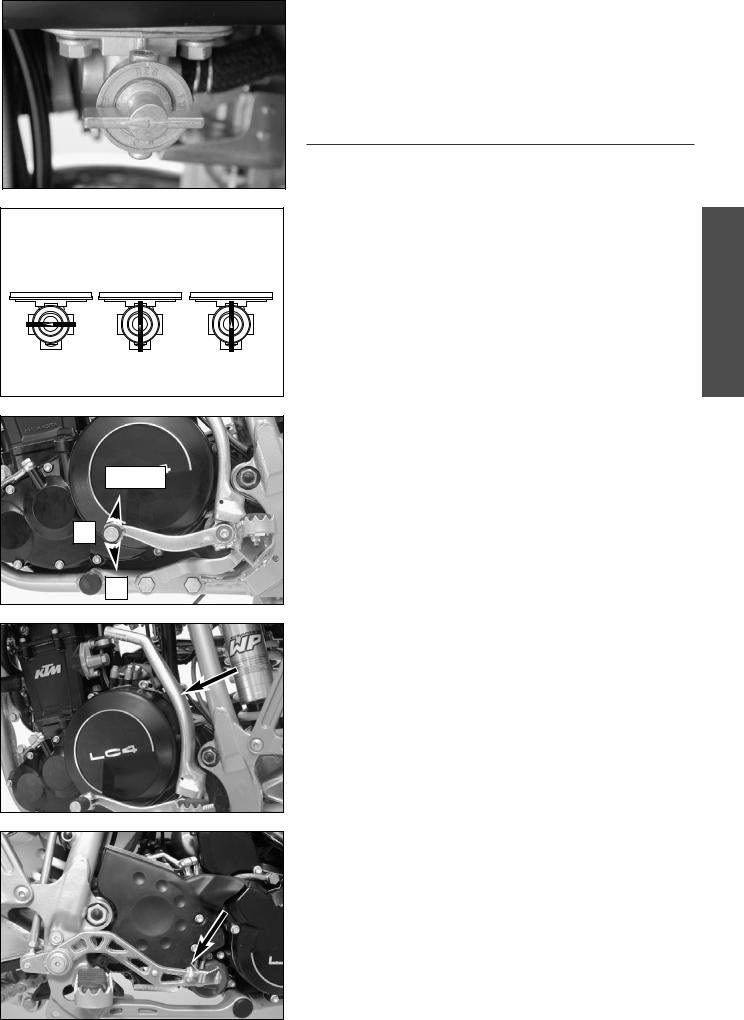
OFF |
ON |
RES |
||||
|
RES |
|
RES |
|
RES |
|
|
F |
|
F |
|
F |
|
F |
U |
F |
U |
F |
U |
|
E |
E |
E |
||||
F |
F |
F |
||||
O |
L |
O |
L |
O |
L |
|
|
ON |
|
ON |
|
ON |
|
2,3,4,5
N
1
Fuel tap
OFF In this position the fuel tap is closed. No fuel may flow to the carburetor.
ON When using the motorcycle, the twist grip must be set to the ON position. Now fuel may flow to carburetor. In this position the tank empties down to the fuel reserve of approx. 2.5 liters.
RES The reserve, approximately 2.5 liters, cannot be tapped until the twist grip is turned to the RES position. Fill the tank as soon as possible and remember to turn the twist grip back to the ON position so that you will have backup fuel next time, too.
! |
CAUTION |
! |
THE FUEL TAP SHOULD BE LOCKED WHENEVER THE MOTORCYCLE IS PARKED. IF THE TAP IS NOT CLOSED THE CARBURETOR MAY OVERFLOW AND FUEL CAN GET INTO THE ENGINE.
ENGLISH 7
Shift lever
The shift lever is mounted on the left side of the engine. The position of the gears is shown in the illustration. Neutral, or the idle speed, is located between first and second gear.
Kickstarter
The kickstarter is mounted on the left side of the engine. Its upper part can be swivelled.
|
WARNING |
|
– WHEN STARTING THE ENGINE, MAKE SURE THAT YOU ALWAYS WEAR STURDY MOTORCYCLING BOOTS IN ORDER TO AVOID INJURY. YOU MIGHT SLIDE OFF THE KICKSTARTER, OR THE ENGINE MAY CAUSE THE KICKSTARTER TO RECOIL, THEREBY CAUSING INJURIES TO FOOT AND LEG.
–ALWAYS KICK THE KICKSTARTER BRISKLY ALL THE WAY AND, WHILE DOING SO, NEVER OPEN THE THROTTLE. KICKSTARTING WITH INSUFFICIENT MOMENTUM AND AN OPENED THROTTLE LEVER INCREASES THE DANGER OF A POSSIBLE RECOIL.
Foot brake pedal
The foot brake pedal is located in front of the right footrest. Its basic position can be adjusted to your seat position (see maintenance work).
|
WARNING |
|
IF THE RESISTANCE IN THE HAND BRAKE LEVER OR FOOT BRAKE PEDAL FEELS “SPONGY” (TOO MUCH GIVE), THIS IS AN INDICATION THAT SOMETHING IS WRONG WITH THE BRAKE SYSTEM. DON’T RIDE YOUR MOTORCYCLE ANYMORE WITHOUT FIRST HAVING THE BRAKE SYSTEM LOOKED OVER BY A KTM DEALER.

ENGLISH 8
A
2
3 |
Compression damping of fork
The compression damping is to be set at the lower end of the fork tubes. It only regulates the degree of damping during compression. Remove closing cap A. By using the knob 1 (COM), the degree of damping of the compression can be adjusted. Turn the knob clockwise to increase damping, turn it counterclockwise to reduce damping during compression.
BASIC SETTING:
–turn rotary knob clockwise as far as it will go
–turn it back counter-clockwise by as many clicks as are specified for the
relevant type of fork |
|
|
|
WP 0518W714 ....... |
20 Klicks |
(640 |
LC4) |
WP 0518W722 ....... |
14 Klicks |
(640 |
LC4 Supermoto) |
Rebound damping of fork
The rebound damping is to be set at the upper end of the fork tubes. It only regulates the degree of damping during rebounding.
By using the knob 2 (REB), the degree of damping of the rebound can be adjusted. Turn the knob clockwise to increase damping, turn it counterclockwise to reduce damping during rebounding.
BASIC SETTING:
–turn rotary knob clockwise as far as it will go
–turn it back counter-clockwise by as many clicks as are specified for the relevant type of fork
WP 0518W714 ....... |
12 Klicks |
(640 |
LC4) |
WP 0518W722 ....... |
14 Klicks |
(640 |
LC4 Supermoto) |
Compression damping of shock absorber
With the knob 3 the degree of damping of the compression can be adjusted to 7 positions. Turn the knob counterclockwise to increase damping, turn it clockwise to reduce damping during compression.
BASIC SETTING: |
Position 6 |
(640 |
LC4) |
WP 0118W724............ |
|||
WP 0118W721............ |
Position 5 |
(640 |
LC4 Supermoto) |
Rebound damping of shock absorber
With the setting wheel 4 the degree of damping of the rebound can be adjusted to 11 positions. Turn the knob to the left side to increase damping, turn it to the right side to reduce damping during rebounding.
|
|
BASIC SETTING: |
|
|
|
|
|
|
WP 0118W724 |
Position 7 |
(640 |
LC4) |
|
4 |
|
|||||
|
WP 0118W721............ |
Position 7 |
(640 |
LC4 Supermoto) |
|
|
|
|
|
|
|||
|
|
|
WARNING |
|
||
–NEVER CHANGE DAMPING BETWEEN THE TEST DRIVES MORE THAN 2 CLICKS.
–THE DAMPING UNIT OF THE SHOCK ABSORBER IS FILLED WITH HIGHLY COMPRESSED
NITROGEN. NEVER TRY TO TAKE THE SHOCK ABSORBER APART OR TO DO ANY MAINTENANCE WORK YOURSELF. SEVERE INJURIES COULD BE THE RESULT.
Holding bars
The passenger can hold on to the holding bars on the rear end of the vehicle.
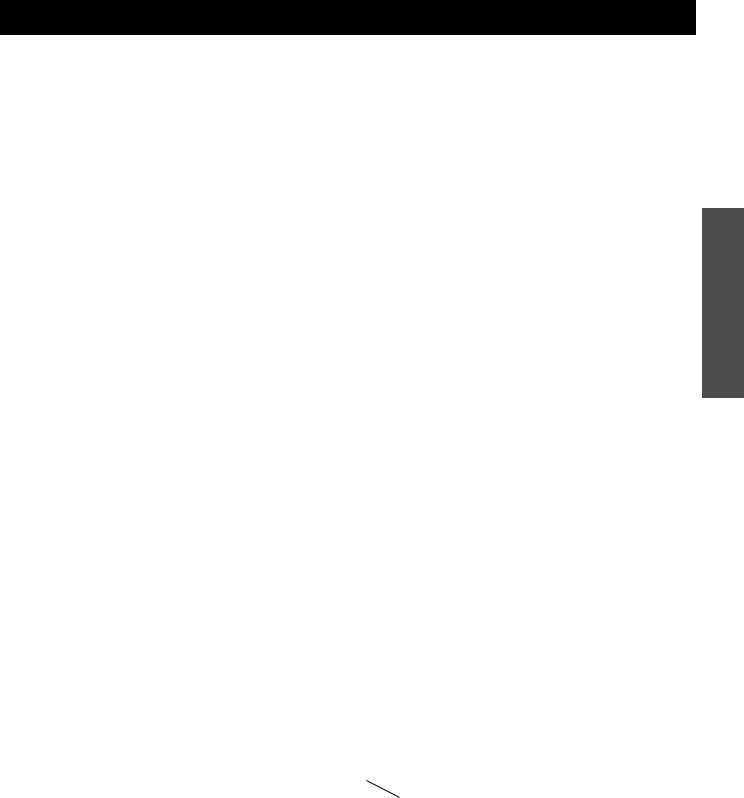
DRIVING INSTRUCTIONS
Check the following before each start
When you start off, the motorcycle must be in a perfect technical condition. For safety reasons, you should make a habit of performing an overall check of your motorcycle before each start.
The following checks should be performed:
1CHECK THE OIL LEVEL
Insufficient oil results in premature wear and consequently to engine damage.
2FUEL
Check that there is sufficient fuel in the tank; when closing the filler cap.
3CHAIN
A loose chain can fall off; an extremely worn chain can tear, and insufficient lubrication can result in unnecessary wear to the chain and rear sprockets.
4TIRES
Check for damaged tires. Tires showing cuts or dents must be replaced. The tread depth must comply with the legal regulations. Also check the air pressure. Insufficient tread and incorrect air pressure reduce the driving performance.
5BRAKES
Check the brakes for proper functioning as well as the brake-fluid level in the tanks. The reservoirs have been designed in such a way that brake fluid does not need to be refilled even when the brake pads are worn. If the level of
brake fluid falls below the minimum value, this indicates a leak in the braking system or completely worn out brake pads. Arrange for the braking system to be checked by a KTM specialist garage, as complete failure of the braking system can be expected.
Also check the state of the brake hoses and the thickness of the brake linings.
Check free travel at hand brake lever and foot brake pedal.
6CABLES
Check correct setting and easy running of all control cables.
7COOLING LIQUID
Check the level of cooling liquid when the engine is cold.
8ELECTRICAL SYSTEM
Check headlight, parking light, tail light, brake light, flashers, indicator lamps and horn for faultless operation.
9LUGGAGE
If you are taking luggage with you, check that this is securely fastened.
|
WARNING |
|
–WEAR SUITABLE CLOTHING WHEN DRIVING A MOTORCYCLE. CLEVER KTM DRIVERS ALWAYS WEAR A HELMET, BOOTS, GLOVES AND A
JACKET, REGARDLESS OF WHETHER DRIVING ALL DAY OR JUST FOR A SHORT TRIP. THE PROTECTIVE CLOTHING SHOULD BE BRIGHTLY COLOURED SO THAT OTHER USERS OF THE ROADS CAN SEE YOU AS EARLY AS POSSIBLE. YOUR PASSENGER OF COURSE WILL ALSO NEED SUITABLE PROTECTIVE CLOTHING.
– ALWAYS TURN ON THE LIGHT TO MAKE SURE THAT OTHER DRIVERS BECOME AWARE OF YOU AS EARLY AS POSSIBLE.
–DO NOT DRIVE AFTER HAVING CONSUMED ALCOHOL.
–ONLY USE ACCESSORIES THAT HAVE BEEN RELEASED BY KTM. FOR
EXAMPLE, FRONT PANELLING CAN IMPAIR THE DRIVING PROPERTIES OF THE MOTORCYCLE. CASES, EXTRA TANKS ETC. CAN ALTER THE WEIGHT DISTRIBUTION AND THUS ALSO IMPAIR THE VEHICLE’S DRIVING PROPERTIES.
– THE FRONT AND REAR WHEEL ARE ONLY ALLOWED TO BE TIRED WITH TIRES THAT HAVE THE SAME PROFILE TYPE.
Instructions for initial operation
–Verify that your KTM dealer performed the PREPARATION OF VEHICLE jobs (see Customer Service Manual).
–Read the entire manual carefully before your first drive.
–Familiarize yourself with the operating elements.
–Adjust the hand brake lever and the foot brake pedal to the most comfortable positions for you.
–Get used to handling the motorcycle on an empty car park, before starting on a longer drive. Also try to drive as slowly as possible and in standing position, to improve your feeling for the vehicle.
–Do not drive along off-road tracks which go beyond your ability and experience.
–Hold the handlebar with both hands and leave your feet on the foot rests while driving.
–Remove your foot from the foot brake pedal when you are not braking. If the foot brake pedal is not released the brake pads rub continuously and the braking system is overheated.
–You may only be accompanied by a passenger if your motorcycle is fitted and registered for such purposes. The passenger must hold tight to the brackets or hold on to the driver during the drive, with his feet on the passenger foot rests.
–Do not make any alterations to the motorcycle and always use ORIGINAL KTM SPARE PARTS. Spare parts from other manufacturers can impair the safety of the motorcycle.
–Motorcycles are sensitive to alterations in the distribution of weight. If you are taking luggage with you, this should be secured as close as possible to the middle of the vehicle; distribute the weight evenly between the front and rear wheel. Never exceed the maximum permissible laden weight and the axle weights. The maximum permissible laden weight is made up of the following components:
–Motorcycle ready for operation and tank full
–Luggage
–Driver and passenger with protective clothing and helmet.
–Pay attention to running in instructions.
Running in the LC4 models
Even finely machined surfaces of engine parts have rougher surfaces than parts that slide on each other for a long time. Therefore, every engine must be run in. For this reason, do not demand maximum performance from the engine for the first 100 kilometers. The vehicle must be run in at low, changing performance level for the first 1000 KM (620 miles). The engine speed of 4800 r.p.m. must not be exceeded during the first 1000 kilometers (620 miles). During this break-in time, you should ride your motorcycle in different conditions. The following table shows you the maximum velocity values in the different gears at 4800 r.p.m. as based on the rear wheel transmission ratio of your motorcycle.
Exceeding the above listed rotations as well as pushing high rpm when the engine is cold will have an adverse effect on the life of your engine.
ratio |
640 LC4 |
Supermoto |
|
|
|
|
16:42 t |
17:42 t |
|
|
|
|
|
gear |
|
|
|
|
||
1st |
35 (22) |
35 (22) |
|
|
|
|
|
|
|
|
|
|
|
2nd |
50 (32) |
50 (32) |
|
|
|
|
|
|
|
|
|
|
|
3rd |
70 (44) |
70 (44) |
|
|
|
|
|
|
|
|
|
|
|
4th |
90 (57) |
90 (57) |
|
|
|
|
|
|
|
|
|
|
|
5th |
100 (63) |
100 (63) |
|
|
|
|
|
|
|
|
|
|
|
km/h (mph)
NOTE:
DURING THE STAGE OF RUNNING THE ENGINE IN, THAT IS THE FIRST 1000 KM (620 MILES), THE ENGINE OIL USED SHOULD BE OF A
MINERAL OIL FORMULA. THIS ALSO APPLIES IF THE ENGINE HAS BEEN REPAIRED.
ENGLISH 9
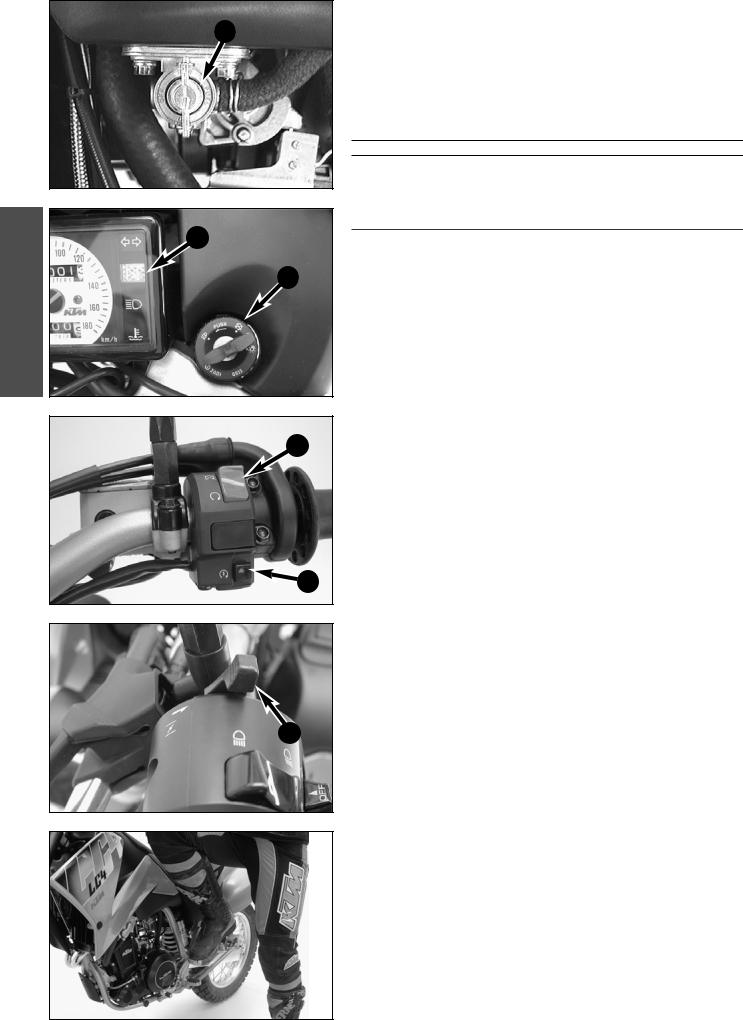
ENGLISH
10
1
4
3
6
5
Starting when the engine is cold
1Open the fuel tap 1
2Switch on ignition (turn ignition key 2 into position  ).
).
3Switch on emergency OFF switch 3.
4Switch transmission to idle (green indicator lamp N 4 lights up).
5Operate cold starting device (choke) 5.
6Do not accelerate; operate starter button 6.
7If the engine starts, push the choke lever back a little bit, as soon as the engine runs unevenly.
8Take the motorcycle off of the main stand or side stand.
WARNING
– TO AVOID INJURIES, IT IS RECOMMENDED TO WEAR BOOTS WHEN USING THE KICKSTARTER.
– DO NOT START THE ENGINE AND ALLOW IT TO IDLE IN A CLOSED ROOM. EXHAUST FUMES ARE POISONOUS AND CAN CAUSE LOSS OF CONSCIOUSNESS AND DEATH. ALWAYS PROVIDE ADEQUATE VENTILATION WHILE THE ENGINE IS RUNNING.
! |
CAUTION |
! |
– MAXIMUM PERIOD FOR CONTINUOUS STARTING: 5 SECONDS. WAIT AT LEAST
5 SECONDS BEFORE TRYING AGAIN.
–DON’T RIDE YOUR MOTORCYCLE WITH FULL LOAD AND DON’T REV ENGINE WHEN
COLD. BECAUSE THE PISTON IS WARMING UP FASTER THAN THE WATER COOLED CYLINDER, IT CAN CAUSE ENGINE DAMAGE. ALWAYS LET THE ENGINE WARM UP BEFORE AND REFRAIN FROM DRIVING WITH FULL LOAD UNTIL THE ENGINE IS WARM.
IF THE ENGINE IS DOES NOT CRANK WHEN YOU ACTUATE THE STARTER TIP SWITCH:
–the transmission is switched to idle
–Check if the emergency OFF switch is on
–Check if the ignition is on
–the headlight is on (ignition lock in position 

 ).
).
–If this is not the case, the battery is discharged
–If the lights are on, proceed as described in the „Trouble-shooting“ section or contact a KTM dealer.
IF THE ENGINE CRANKS BUT DOES NOT START, WHEN YOU ACTUATE THE STARTER TIP SWITCH:
–Check if the fuel tap is open
–Check if the choke lever has been operated
–Check if sufficient fuel is in the tank
–If this is not the case, refill the tank
–if sufficient fuel is in the tank, proceed as described in the „Troubleshooting“ section or contact a KTM dealer.
NOTE LC4:
This motorcycle is equipped with a safety starter system. The engine can only be started when the transmission is switched to idle or the clutch lever is pulled, respectively.
NOTE LC4 SUPERMOTO:
This motorcycle is equipped with a safety starter system. The engine can only be started when the transmission is switched to idle or the clutch lever is pulled, respectively.
Motorcycles with side stands are also equipped with a safety starting system.
If you put in a gear with the side stand in its swung-out position, and if you let go of the clutch lever, the engine will stop.
Starting when the engine is warm or hot
1Open the fuel tap 1
2Switch on ignition (turn ignition key 2 into position  ).
).
3Switch on emergency OFF switch 3.
4Switch transmission to idle (green indicator lamp N 4 lights up).
5Do not accelerate; operate starter button 6.
6Take the motorcycle off of the main stand or side stand.

What to do when the engine is „flooded”
The throttle must be fully opened when starting. If necessary change spark-plug.
Kickstart instructions
Start as described above, then push the kickstarter hard ALL THE WAY.
|
WARNING |
|
– WHEN STARTING THE ENGINE, MAKE SURE THAT YOU ALWAYS WEAR STURDY MOTORCYCLING BOOTS IN ORDER TO AVOID INJURY. YOU MIGHT SLIDE OFF THE KICKSTARTER, OR THE ENGINE MAY CAUSE THE KICKSTARTER TO RECOIL, THEREBY CAUSING INJURIES TO FOOT AND LEG.
–ALWAYS KICK THE KICKSTARTER BRISKLY ALL THE WAY AND, WHILE DOING SO, NEVER OPEN THE THROTTLE. KICKSTARTING WITH
INSUFFICIENT MOMENTUM AND AN OPENED THROTTLE LEVER INCREASES THE DANGER OF A POSSIBLE RECOIL.
Starting off
Pull the clutch lever. Put the engine into first gear, slowly release the clutch lever and open throttle at the same time.
|
WARNING |
|
– BEFORE YOU START OFF, CHECK THAT THE MAIN STAND HAS BEEN SWUNG UP FULLY. IF THE STAND DRAGS ON THE GROUND, THE MOTORCYCLE CAN GO OUT OF CONTROL.
– ALWAYS TURN ON THE LIGHT TO MAKE SURE THAT OTHER DRIVERS BECOME AWARE OF YOU AS EARLY AS POSSIBLE.
Shifting/Riding
You are now in first gear, refered to as the drive or uphill gear. Depending on the conditions (traffic, road gradient, etc.), you can shift to a higher gear. Close throttle, at the same time pull clutch lever and shift to the next higher gear. Let clutch lever go again and open throttle. If you turned on the choke, make sure you turn it off again as soon as engine is warm.
When you reach full speed through turning the throttle grip all the way, turn throttle back to 3/4; the speed hardly decreases although the engine will use less gas. Never open the throttle wider than the engine can handle. Excessive turning of the throttle grip will increase full consumption.
By shifting down, use the brakes if necessary and close throttle at the same time. Pull clutch lever and shift down to the next gear. Let clutch lever go slowely and open throttle or shift down again.
If the engine is killed f.ex. at a crossing, simply pull the clutch lever and start. It is not necessary to switch the gear to NEUTRAL.
|
WARNING |
|
– OBSERVE THE TRAFFIC REGULATIONS, DRIVE DEFENSIVELY AND TRYING TO LOOK AHEAD AS FAR AS POSSIBLE SO THAT ANY HAZARDS CAN BE RECOGNIZED AS EARLY AS POSSIBLE.
– ADJUST YOUR DRIVING SPEED ACCORDING TO THE CONDITIONS AND YOUR DRIVING SKILLS.
–DRIVE CAREFULLY ON UNKNOWN ROADS
–AVOID ABRUPT LOAD CHANGES WHILE RIDING AROUND BENDS AND
ON WET OR SLIPPERY GROUND. OTHERWISE YOU MIGHT EASILY LOSE CONTROL OVER YOUR MOTORCYCLE.
–WHILE RIDING YOUR MOTORCYCLE, NEVER SWITCH THE IGNITION LOCK TO POSITIONS  AND
AND  .
.
–RENEW THE VIZOR ON YOUR HELMET OR THE GLASS OF YOUR
GOGGLES ON TIME SO AS TO ENSURE OPTIMUM VISION IN ANY SITUATION.
–WHEN DRIVING OFF-ROAD, ALWAYS HAVE A FRIEND ON A SECOND MOTORCYCLE TO KEEP YOU COMPANY, SO THAT YOU CAN HELP EACH OTHER SHOULD DIFFICULTIES ARISE.
–REPLACE THE HELMET VISOR RESPECTIVELY GOGGLE GLASSES IN PLENTY OF TIME. WHEN LIGHT SHINES DIRECTLY ON SCRATCHED VISOR OR GOGGLES, YOU WILL BE PRACTICALLY BLIND.
– AFTER FALLING WITH THE MOTORCYCLE, CHECK ALL FUNCTIONS THOROUGHLY BEFORE STARTING UP OPERATIONS AGAIN.
– A DEFORMED HANDLEBAR MUST ALWAYS BE REPLACED. UNDER NO CIRCUMSTANCES SHOULD YOU STRAIGHTEN THE HANDLEBAR WHICH WOULD CONSEQUENTLY LOSE ITS STABILITY.
! |
CAUTION |
! |
– HIGH RPM RATES WHEN THE ENGINE IS COLD HAVE AN ADVERSE EFFECT ON THE LIFE OF YOUR ENGINE. WE RECOMMEND YOU RUN THE ENGINE IN A MODERATE RPM RANGE FOR A FEW MILES GIVING IT A CHANCE TO WARM UP. AFTER THAT NO FURTHER PRECAUTIONS IN THIS RESPECT NEED BE TAKEN. THE ENGINE HAS REACHED ITS OPERATING TEMPERATURE AS SOON AS THE RADIATORS BECOME WARM.
– NEVER HAVE THE THROTTLE WIDE OPEN WHEN CHANGING DOWN TO A LOWER GEAR. THE ENGINE WILL OVERSPEED, DAMAGING THE VALVES. IN ADDITION, THE REAR WHEEL BLOCKS SO THAT THE MOTORCYCLE CAN EASILY GET OUT OF CONTROL.
– LONG WHEELIES LEAD TO A DROP IN THE OIL PRESSURE WHICH CAN LEAD TO ENGINE DAMAGE.
– NEVER USE YOUR MOTORCYCLE WITHOUT AN AIR FILTER. OTHERWISE DUST AND DIRT MAY ENTER THE ENGINE AND CAUSE INCREASED WEAR.
–THE RED COOLANT WARNING LAMP LIGHTS UP WHEN THE COOLANT
TEMPERATURE HAS REACHED 105°C.
POSSIBLE CAUSES FOR THE INCREASE IN TEMPERATURE:
-LOW DRIVING VELOCITY AND HIGH LOAD SITUATION IN HIGH AIR TEMPERATURES
-LEVEL OF COOLANT IN THE SYSTEM IS INSUFFICIENT -FAN AT LEFT RADIATOR IS NOT RUNNING
-IMPROPER USE OF THE CLUTCH WHILE DRIVING AT LOW VELOCITIES PLACE A CLOTH ON THE RADIATOR CAP. OPEN THE CAP SLOWLY, SO
THE EXCESS PRESSURE IN THE COOLING SYSTEM CAN ESCAPE.
- CAUTION SCALDING HAZARD! - AND CHECK THE COOLING
LIQUID LEVEL.
DO NOT DRIVE ON, UNTIL THERE IS SUFFICIENT LIQUID IN THE COLING SYSTEM. HOWEVER, CALL ON ONE OF KTM’S DEALERS AS SOON AS
POSSIBLE IN ORDER TO HAVE THE DEFECT REMEDIED.
– IF ANY ABNORMAL VIBRATIONS OCCUR WHILE DRIVING, CHECK THAT THE ENGINE FASTENING BOLTS ARE TIGHT.
– IN THE EVENT THAT, WHILE RIDING ON YOUR MOTORCYCLE, YOU NOTICE ANY UNUSUAL OPERATION-RELATED NOISE, STOP IMMEDIATELY, TURN THE ENGINE OFF, AND CONTACT AN AUTHORIZED KTM DEALER.
Braking
Close throttle and apply the hand and foot brakes at the same time. When driving on sandy, wet or slippery ground use mainly the rear wheel brake. Always brake with feeling, blocking wheels can cause you to skid or fall. Also change down to lower gears depending on your speed.
When driving downhill, use the braking effect of the engine. Change down one or two gears but do not overspeed the engine. In this way, you will not need to brake so much and the brakes will not overheat.
|
WARNING |
|
–IN THE RAIN, OR AFTER THE MOTORCYCLE HAS BEEN WASHED, BRAKING ACTION MAY BE DELAYED DUE TO WET BRAKE DISCS. FIRST, THE BRAKES MUST BE BRAKED DRY.
–ON SALT-SPRAYED OR DIRTY ROADS BRAKE ACTION MAY BE DELAYED AS WELL. FIRST, THE BRAKES MUST BE BRAKED CLEAN.
–WHEN YOU BRAKE, THE BRAKE DISCS, BRAKE PADS, BRAKE CALIPER AND BRAKE FLUID HEAT UP. THE HOTTER THESE PARTS GET, THE WEAKER THE BRAKING EFFECT. IN EXTREME CASES, THE ENTIRE BRAKING SYSTEM CAN FAIL.
ENGLISH
11
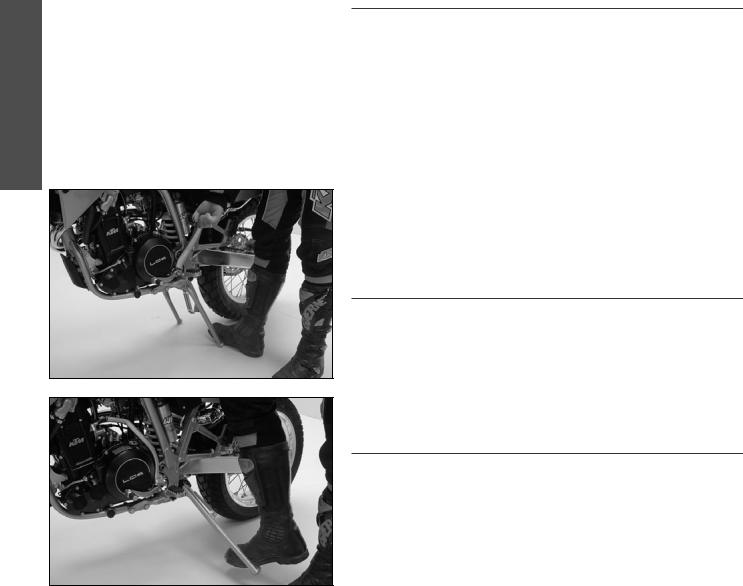
ENGLISH
12
Stopping and parking
Apply the brakes fully and put the engine into neutral. To stop the engine, switch off the ignition. Turn the fuel tap to the OFF position, park on an area where the ground is firm, and lock the motorcycle.
|
WARNING |
|
–ALWAYS PARK YOUR MOTORBIKE ON A SOLID AND HORIZONTAL SURFACE.
–NEVER LEAVE YOUR MOTORCYCLE WITHOUT SUPERVISION AS LONG AS THE ENGINE IS RUNNING.
–MOTORCYCLE ENGINES PRODUCE A GREAT AMOUNT OF HEAT WHILE RUNNING. THE ENGINE RADIATORS, EXHAUST, EXHAUST SYSTEM, BRAKE DISCS, AND SHOCK ABSORBERS CAN BECOME VERY HOT. DO NOT TOUCH ANY OF THESE PARTS AFTER OPERATING THE MOTORCYCLE, AND TAKE CARE TO PARK IT WHERE PEDESTRIANS ARE
NOT LIKELY TO TOUCH IT AND GET BURNED
–NEVER PARK YOUR MOTORCYCLE IN PLACES WHERE THERE EXIST FIRE HAZARDS DUE TO DRY GRASS OR OTHER EASILY FLAMMABLE MATERIALS.
! |
CAUTION |
! |
– CLOSE THE FUEL TAP WHEN LEAVING YOUR VEHICLE.OTHERWISE THE CARBURETOR CAN OVERFLOW AND FUEL WILL ENTER THE ENGINE.
– ALWAYS TAKE OUT THE IGNITION KEY WHEN PARKING YOUR MOTORCYCLE SO THAT IT CANNOT BE USED BY UNAUTHORIZED PERSONS.
NOTE REGARDING THE CENTER STAND:
We advise the following procedure to place the motorcycle on the center stand as effortlessly as possible:
a)press main stand to ground using foot
b)swing out kickstarter and pull motorcycle backwards at an angle as illustrated (see illustration).
Make sure that the ground is solid and that your motorcycle is standing securely.
! |
CAUTION |
! |
THE CENTER STAND IS DESIGNED TO HOLD THE WEIGHT OF THE MOTORCYCLE ONLY. BY SITTING ON THE MOTORCYCLE, YOU WILL PUT ADDITIONAL WEIGHT ON THE CENTER STAND, POSSIBLY CAUSING THE CENTER STAND OR FRAME TO BE DAMAGED OR THE MOTORCYCLE TO FALL DOWN.
INFORMATION ABOUT THE SIDE STAND:
Use your foot to push the side stand forward as far as possible, and lean your motorcycle to the side. Make sure that your motorcycle is standing safely on solid ground. Just in case, you can also put in a gear.
! |
CAUTION |
! |
THE SIDE STAND IS DIMENSIONED FOR THE WEIGHT OF THE MOTORCYCLE ONLY. IF YOU ARE SITTING ON THE MOTORBIKE AND THUS APPLY AN ADDITIONAL LOAD ONTO THE SIDE STAND, YOU MAY CAUSE DAMAGE TO THE SIDE STAND OR THE FRAME, AND YOUR MOTORBIKE MAY FALL OVER.

ENGLISH
13
